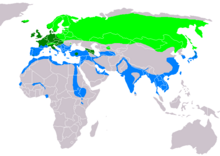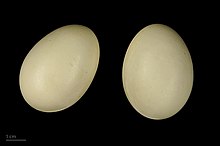Eurasian teal
| Eurasian teal | |
|---|---|

| |
| Wintering male from Mangaon, Maharashtra, India | |
| Scientific classification | |
| Domain: | Eukaryota |
| Kingdom: | Animalia |
| Phylum: | Chordata |
| Class: | Aves |
| Order: | Anseriformes |
| Family: | Anatidae |
| Genus: | Anas |
| Species: | A. crecca
|
| Binomial name | |
| Anas crecca | |

| |
| Distribution map light green : nesting area blue : wintering area dark green : resident all year | |
| Synonyms | |
|
Anas crecca crecca Linnaeus, 1758 | |
The Eurasian teal (Anas crecca), common teal, or Eurasian green-winged teal is a common and widespread
.It is a highly gregarious duck outside the breeding season and can form large flocks. It is commonly found in sheltered wetlands and feeds on seeds and aquatic invertebrates. The North American green-winged teal (A. carolinensis) was formerly (and sometimes is still) considered a subspecies of A. crecca.
Taxonomy
The Eurasian teal belongs to the "true" teals, a group of small
Whether the Eurasian and green-winged teals are to be treated as one or two species is still being reviewed by the
The Eurasian teal was first scientifically named by
The scientific name is from
Description
The Eurasian teal is one of the smallest extant
From a distance, the drakes in
In non-breeding (eclipse) plumage, the drake looks more like the hen; it is more uniform in colour, with a dark head and vestigial facial markings. The hen itself is yellowish-brown, somewhat darker on wings and back. It has a dark greyish-brown upper head, hindneck, eyestripe and feather pattern. The pattern is dense short streaks on the head and neck, and scaly spots on the rest of the body; overall they look much like a tiny
Immatures are coloured much like hens, but have a stronger pattern. The downy young are coloured like in other dabbling ducks: brown above and yellow below, with a yellow supercilium. They are recognizable by their tiny size however, weighing just 15 g (0.53 oz) at hatching.[3][17][18]
The drake's bill is dark grey, in eclipse plumage often with some light greenish or brownish hue at the base. The bill of hens and immatures is pinkish or yellowish at the base, becoming dark grey towards the tip; the grey expands basewards as the birds age. The feet are dark grey in males and greyish
Moults during summer. Male in eclipse resembles female, but with darker upperparts and grey bill. Flight feathers are moulted simultaneously and birds are flightless for up to 4 weeks.[19]
This is a noisy species. The male whistles cryc or creelycc, not loud but very clear and far-carrying. The female has a feeble keh or neeh
Males in nuptial plumage are distinguished from
-
Female, WWT Slimbridge in Gloucestershire, England
-
Drake ineclipse plumage(rightmost bird), hen and young
Distribution and habitat
The Eurasian teal breeds across the
In winter, there are high densities around the
From tracking wintering teal in Italy, most individuals departed the wintering grounds between mid-February and March, using the Black-Sea-Mediterranean flyway to reach their breeding grounds, from central Europe to east of the Urals, by May. This slow migration is due to long stopovers near the start of migration, mainly in south-eastern Europe.[22]
Altogether, the Eurasian teal is much less common than its American counterpart, though still very plentiful. Its numbers are mainly assessed by counts of wintering birds; some 750,000 are recorded annually around the
The Eurasian teal is one of the species to which the Agreement on the Conservation of African-Eurasian Migratory Waterbirds (
Behaviour

This
The Eurasian teal usually feeds by dabbling, upending or grazing; it may submerge its head and on occasion even dive to reach food. In the breeding season it eats mainly
It nests on the ground, near water and under cover. The pairs form in the winter quarters and arrive on the breeding grounds together, starting about March. The breeding starts some weeks thereafter, not until May in the most northernly locations. The nest is a deep hollow lined with dry leaves and
Notes
References
- ^ . Retrieved 19 November 2021.
- doi:10.1139/z06-201.
- ^ ISBN 84-87334-10-5.
- ^ JSTOR 4088089.
- ^ JSTOR 4089339.
- South American Classification Committee (2008). "Part 1. Struthioniformes to Cathartiformes, Version of 22 December 2008". A classification of the bird species of South America. Retrieved 5 January 2009.
- S2CID 53155090.
- .
- ^ Linnaeus, Carl (1746): 109. Anas macula alarum viridi: linea alba supra infraque oculos. In: Fauna Svecica Sistens Animalia Sveciæ Regni, etc. (1st ed.): 39–40 [in Latin]. Conrad & Georg Jacob Wishoff, Leiden ("Lugdunum Batavorum").
- ^ Gessner, Conrad (1555). Historiae animalium (in Latin). Vol. 3. Zürich [Tigurium]: Christoph Froschauer. pp. 103–105. Archived from the original on 2012-12-05. Retrieved 2009-01-06.
- ^ Aldrovandi, Ulisse (Ulyssis Aldrovandus) (1637). Ornithologia (in Latin). Vol. 3: Tomus tertius ac postremus (2nd ed.). Bologna [Bononia]: Nicolò Tebaldini. pp. 207–209. Archived from the original on 2012-12-11. Retrieved 2009-01-06.
- ^ Willughby, Francis (1676). Ornithologiae libri tres (in Latin). London: John Martyn. p. 290. Archived from the original on 2012-12-09.
- ^ a b Linnaeus, Carl (1758). Systema naturae per regna tria naturae, secundum classes, ordines, genera, species, cum characteribus, differentiis, synonymis, locis. Tomus I. Editio decima, reformata. pp. 126–127.
- ^ Ray, John (Joannis Raii) (1713). Synopsis methodica avium & piscium: opus posthumum, etc (in Latin). Vol. 1. London: William Innys. pp. 147–148. Archived from the original on 2011-07-16. Retrieved 2009-01-06.
- ^ Albin, Eleazar (1731–1738): A natural history of the birds (3 volumes). William Innys, London. Vol.1, p.95, plate 100; vol. 2, p.91, plate 102
- ISBN 978-1-4081-2501-4.
- ^ ISBN 0713636475.
- ^ "Anas crecca life history data". AnAge. 2009. Retrieved 6 January 2009.
- ISBN 978-1-4729-0647-2.
- ^ Wiles, Gary J.; Johnson, Nathan C.; de Cruz, Justine B.; Dutson, Guy; Camacho, Vicente A.; Kepler, Angela Kay; Vice, Daniel S.; Garrett, Kimball L.; Kessler, Curt C.; Pratt, H. Douglas (2004). "New and Noteworthy Bird Records for Micronesia, 1986–2003". Micronesica. 37 (1): 69–96.
- ^ eBird (2023). "Green-winged Teal". eBird Status and Trends, Data Version: 2022; Released: 2023. Retrieved 7 March 2024.
- hdl:11568/920031.





